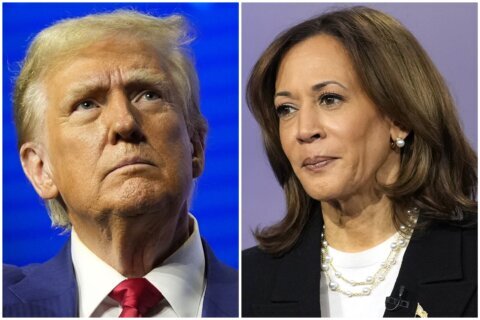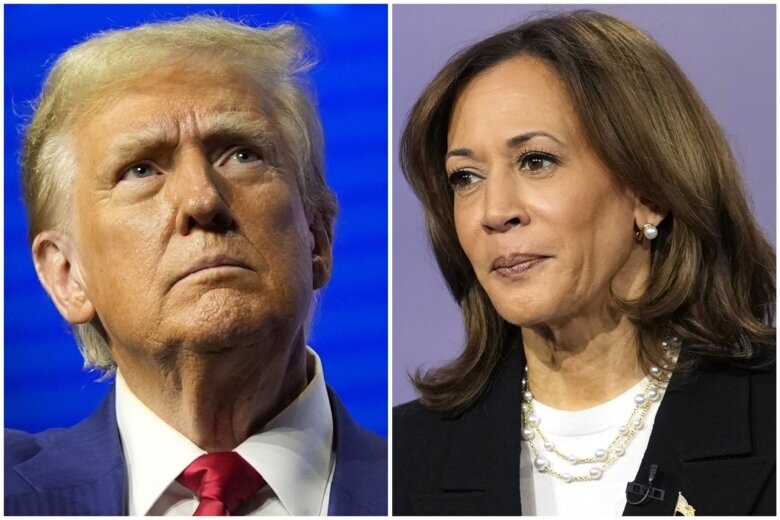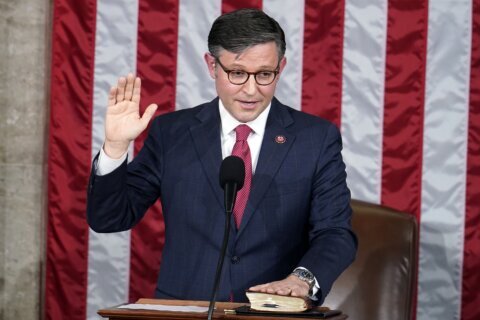
WASHINGTON (AP) — Voters in this year’s presidential election are choosing between two conflicting visions of the United States offered by Democrat Kamala Harris and Republican Donald Trump. The outcome will affect how the country sees itself and how it’s viewed across the world, with repercussions that could echo for decades.
Since replacing President Joe Biden as the Democratic nominee, Harris has pledged to blaze her own path forward. But many of the vice president’s ideas are well trod by Biden: middle-class tax cuts, tax increases on the wealthy and corporations, a restoration of abortion rights, a government that aggressively addresses climate change. and a commitment to uphold democratic values and the rule of law.
Trump has pledged retaliation against rivals as he pushes to fulfill an agenda sidetracked during his previous term by the global pandemic. The former president wants to undertake a mass deportation of migrants who are living in the United States illegally, extend and expand his 2017 tax cuts, greatly increase tariffs and offer more support for fossil fuels and less support for renewable energy. He has attacked transgender rights and pledged to end Russia’s war with Ukraine while suggesting Ukraine must make territorial concessions. He also is seeking to concentrate more government power within the White House.
The candidates have spelled out their ideas in speeches, advertisements and other venues. Both say that their approach would do more to lift up workers, the middle class and the promises that have defined America. While Trump and Harris agree on not taxing workers’ tips, the similarities largely stop there — a further sign of how the election’s outcome could reshape the country.
A look at where each candidate stands on 10 top issues:
HARRIS: She has called on Congress to pass legislation guaranteeing abortion access in federal law, a right that stood for nearly 50 years before being overturned by the Supreme Court in 2022. She has campaigned on how the patchwork of state laws limiting abortion have hurt women’s access to medical care, in one prominent case leading to the death in Georgia of Amber Nicole Thurman.
Harris has promoted the administration’s efforts short of federal law, including steps to protect women who travel to access the procedure and limit how law enforcement collects medical records. Her argument to the public is rooted in the concept of freedom, saying “the freedom to make decisions about one’s own body should not be made by the government.”
TRUMP: He often brags about nominating the Supreme Court justices who overturned Roe v. Wade. After dodging questions about when in pregnancy he believed abortion should be restricted, Trump announced last spring that decisions on access and cutoffs should be left to the states. He has praised the patchwork of restrictions that have emerged across Republican-led states, saying the people are deciding.
He has said he would not sign a national abortion ban into law and would not try to block access to abortion medication, after initially waffling. He told Time magazine that it should also be left up to states to determine whether to prosecute women for abortions or to monitor their pregnancies, but he has not rejected the idea outright. He has said that, if he wins, he wants to make in vitro fertilization treatment free for women. He has even claimed that he is the “father” of the treatment, first used in 1978, even though it has only come under threat because of the overturning of Roe v. Wade.
HARRIS: She has done something of an about-face, saying in her campaign that it’s possible to continue hydraulic fracturing for fossil fuels even as she embraces policies that favor renewable energy resources. Republicans are quick to point out that Harris opposed offshore drilling and fracking during her short-lived campaign for the 2020 presidential nomination.
As a senator from California, Harris was an early sponsor of the Green New Deal, a sweeping series of proposals meant to swiftly move the U.S. to fully green energy. It was a plan championed by the Democratic Party’s most progressive wing. But during her tenure as vice president, Harris has adopted more moderate positions, focusing on implementing the climate provisions of the Biden administration’s Inflation Reduction Act. That provided nearly $375 billion for things such as financial incentives for electric cars and clean energy projects.
The Biden administration has also enlisted more than 20,000 young people in a national Climate Corps, a Peace Corps-like program to promote conservation through projects such as weatherizing homes and repairing wetlands. Despite that, it’s unlikely that the U.S. will be on track to meet Biden’s goal of cutting greenhouse gas emissions in half by 2030.
TRUMP: His mantra for one of his top policy priorities: “DRILL, BABY, DRILL.” Trump, who in the past said climate change was a “hoax” and harbors a particular disdain for wind power, says it’s his goal for the U.S. to have the cheapest energy and electricity in the world. He has claimed he will cut prices in half within a year of his potential return to office. While he often criticizes the Biden administration for its policies, domestic oil production has already been at near-record highs since late 2023, according to the Energy Information Administration.
Trump wants to push that higher by increasing oil drilling on public lands, offering tax breaks to oil, gas and coal producers, speeding the approval of natural gas pipelines, opening dozens of new power plants, including nuclear facilities, and rolling back the Biden administration’s aggressive efforts to get people to switch to electric cars, which he argues have a place but shouldn’t be forced on consumers. He has also pledged to re-exit the Paris climate agreement, end wind subsidies and eliminate regulations imposed and proposed by the Biden administration targeting energy-inefficient kinds of lightbulbs, stoves, dishwashers and shower heads.
HARRIS: Like Biden, Harris has decried Trump as a threat to the nation’s democracy. She has agreed with former Trump administration officials who labeled him a “fascist.”
Harris has leaned more heavily into her personal background as a prosecutor and contrasted that with Trump being found guilty of 34 felony counts in a New York hush money case and being found liable for fraudulent business practices and sexual abuse in civil court. Harris initially talked less frequently than Biden did about Trump’s denial of his 2020 loss and his incitement of the Jan. 6, 2021, assault on the Capitol. But in the closing weeks of the 2024 campaign, she increasingly has framed the prospect of another Trump term as “dangerous.”
TRUMP: After refusing to accept that Biden won, Trump hasn’t committed to accepting the 2024 results. He’s repeatedly promised to pardon the Jan. 6 defendants jailed for assaulting police officers and other crimes during the attack on the Capitol, and recently threatened to jail lawyers, election officials, donors and others “involved in unscrupulous behavior” surrounding November’s vote. He has lashed out at media organizations, threatening their broadcast licenses in response to debate questions and coverage he’s deemed unfair.
Trump has called his Democratic rivals the “enemy within” who are “more dangerous than China, Russia and all these countries.” He pledges to overhaul the Justice Department and FBI “from the ground up,” aggrieved by the criminal charges the department has brought against him. He promises to deploy the National Guard to cities such as Chicago that are struggling with violent crime and in response to protests, and has also pledged to appoint a special prosecutor to go after Biden.
Federal government
HARRIS: Like Biden, Harris has campaigned hard against “Project 2025″ — a plan that Trump has denounced but that was written by leading conservatives and many of his former administration officials.
The plan lays out how to move as swiftly as possible to dramatically remake the federal government and push it to the right if Trump wins the White House. She is also part of an administration that is taking steps to make it harder for any mass firings of civil servants to happen. In April, the Office of Personnel Management issued a new rule that would ban federal workers from being reclassified as political appointees or other at-will employees, thus making them easier to dismiss. That was in response to Schedule F, a 2020 executive order from Trump that reclassified tens of thousands of federal workers to make firing them easier.
TRUMP: The former president has tried to distance himself from Project 2025, despite his close ties to many of its key architects. He has nonetheless pledged to undertake his own overhaul of the federal bureaucracy, which he has long blamed for blocking his first-term agenda, saying: “I will totally obliterate the deep state.” He plans to reissue the Schedule F order stripping civil service protections. He says he would then act to fire “rogue bureaucrats,” including those who ”weaponized our justice system,” and the “warmongers and America-Last globalists in the Deep State, the Pentagon, the State Department, and the national security industrial complex.”
Trump has pledged to terminate the Education Department and wants to curtail the independence of regulatory agencies such as the Federal Communications Commission. As part of his effort to cut government waste and red tape, he has promised to eliminate at least 10 federal regulations for every new one imposed.
HARRIS: Trying to defuse GOP criticism, Harris has said she would sign into law a bipartisan Senate compromise killed by Republican lawmakers at Trump’s request. It would have toughened asylum standards and meant more border agents, immigration judges and asylum officers. She said she would bring back that bill and sign it, saying that Trump “talks the talk, but doesn’t walk the walk” on immigration.
Harris likes to talk up her experience as California attorney general, saying she walked drug smuggler tunnels and successfully prosecuted gangs that moved narcotics and people across the U.S.-Mexico border. Early in his term, Biden made Harris his administration’s point person on the root causes of migration. Trump and top Republicans now blame Harris for a situation at that border, which they say is out of control due to policies that were too lenient. Harris has endorsed a comprehensive immigration overhaul, seeking paths to citizenship for immigrants in the U.S. without legal status, with a faster track for young immigrants living in the country illegally who arrived as children.
TRUMP: He has returned to the harsh immigration rhetoric that marked his previous campaigns. He promises to mount the largest domestic deportation in U.S. history, an operation that could involve detention camps and the National Guard. He would bring back policies he put in place during his first term, like the Remain in Mexico program and Title 42, which placed curbs on migrants on public health grounds. He has called for the death penalty for any migrant who kills a U.S. citizen.
Trump would revive and expand the travel ban that originally targeted citizens from seven Muslim-majority countries. After the Oct. 7, 2023, attack by Hamas on Israel, Trump pledged new “ideological screening” for immigrants to bar “dangerous lunatics, haters, bigots, and maniacs.” He would try to deport people who are in the U.S. legally but harbor “jihadist sympathies.” He would seek to end birthright citizenship for people born in the U.S. whose parents are both in the country illegally.
HARRIS: Harris says Israel has a right to defend itself, and she’s repeatedly decried Hamas as a terrorist organization. But the vice president might have helped defuse some backlash from progressives by being more vocal about the need to better protect civilians during fighting in Gaza.
More than 42,000 Palestinians have been killed in the war in Gaza, according to the Health Ministry in the Hamas-ruled territory. The ministry does not distinguish between civilians and militants in its count, but says that women and children make up just over half of the dead. Israel says it has killed more than 17,000 militants in the war.
Like Biden, Harris supports a proposed hostage-for-extended cease-fire deal that aims to bring all remaining hostages and Israeli dead home. Biden and Harris say the deal could lead to a permanent end to the war and they have endorsed a two-state solution, which would have Israel existing alongside an independent Palestinian state. But Biden is also confronting the prospect of a widening conflict in Lebanon and attacks by Iran even as they both see Israel’s recent killing of Hamas leader Yahya Sinwar as a reason for a cease-fire to be more likely.
TRUMP: He has expressed support for Israel’s efforts to “destroy” Hamas, but he’s also been critical of some of Israel’s tactics. He says the country must finish the job quickly and get back to peace. He has called for more aggressive responses to pro-Palestinian protests at college campuses and applauded police efforts to clear encampments. Trump also proposes to revoke the student visas of those who espouse antisemitic or anti-American views and deport those who support Hamas.
HARRIS: During her rallies, Harris accuses Trump and his party of seeking to roll back a long list of freedoms, including the ability “to love who you love openly and with pride.” She leads audiences in chants of “We’re not going back.”
While her campaign has yet to produce specifics on its plans, she has been part of a Biden administration that regularly denounces discrimination and attacks against the LGBTQ+ community. Early in Biden’s term, his administration reversed an executive order from Trump that had largely banned transgender people from military service. His Education Department issued a rule that says Title IX, the 1972 law protecting women’s rights, also bars discrimination based on sexual orientation or gender identity. That rule was silent on the issue of transgender athletes.
TRUMP: He has pledged to keep transgender women out of women’s sports and says he will ask Congress to pass a bill establishing that “only two genders,” as determined at birth, are recognized by the United States. He promises to “defeat the toxic poison of gender ideology.”
As part of his crackdown on gender-affirming care, he would declare that any health care provider participating in the “chemical or physical mutilation of minor youth” no longer meets federal health and safety standards and is barred from receiving federal money. He would take similarly punitive steps in schools against any teacher or school official who “suggests to a child that they could be trapped in the wrong body.”
Trump would support a national prohibition of hormonal or surgical intervention for transgender minors and bar transgender people from military service.
and
HARRIS: The vice president has yet to specify how her positions on Russia’s war with Ukraine might differ from Biden’s, other than to praise his efforts to rebuild alliances unraveled by Trump, particularly NATO, the military alliance that is a critical bulwark against Russian aggression.
The Biden administration has pledged unceasing support for Ukraine against Russia’s invasion. Washington has sent tens of billions of dollars in military and other aid to Ukraine, including $61 billion in weapons, ammunition and other assistance that is expected to last through the end of this year. The government has also reached an agreement with allies to provide Ukraine with a $50 billion loan — with $20 billion from the United States — that would be backed by frozen Russian financial assets.
The administration has maintained that continuing U.S. assistance is critical because Russian leader Vladimir Putin will not stop at invading Ukraine. Harris has said previously that it would be foolish to risk global alliances the U.S. has established and decried Putin’s “brutality.”
TRUMP: The former president has repeatedly taken issue with U.S. aid to Ukraine and says he will continue to “fundamentally reevaluate” the mission and purpose of the NATO alliance if he returns to office. He has claimed, without explanation, that he will be able to end the war before his inauguration by bringing both sides to the negotiating table. (His approach seems to hinge on Ukraine giving up at least some of its Russian-occupied territory in exchange for a cease-fire.)
On NATO, he has assailed member nations for years for failing to meet agreed-upon military spending targets. Trump drew alarms this year when he said that, as president, he had warned leaders that he would not only refuse to defend nations that don’t hit those targets, but that he also “would encourage” Russia “to do whatever the hell they want” to countries that are “delinquent.”
and
HARRIS: The Biden-Harris administration has tried to boost trade with allies in Europe, Asia and North America, while using tariffs and other targeted tools to go after rivals such as China. The Democratic administration kept Trump’s tariffs on China in place, while adding a ban on exporting advanced computer chips to that country and providing incentives to boost U.S. industries.
In May, the administration specifically targeted China with increased tariffs on electric vehicles and steel and aluminum, among other products.
TRUMP: He wants a dramatic expansion of tariffs on nearly all imported foreign goods, saying that “we’re going to have 10% to 20% tariffs on foreign countries that have been ripping us off for years.” He has suggested tariffs of 100% or more on Chinese goods. He treats these taxes as a way to fund other tax cuts, lower the deficit and possibly fund child care — though economists say the tariffs could raise prices for consumers without generating the revenues Trump promises.
Trump would urge Congress to pass legislation giving the president authority to impose a reciprocal tariff on any country that imposes one on the U.S. Much of his trade agenda has focused on China. Trump has proposed phasing out Chinese imports of essential goods including electronics, steel and pharmaceuticals and wants to ban Chinese companies from owning U.S. infrastructure in sectors such as energy, technology and farmland.
HARRIS: With much of the 2017 tax overhaul expiring at end of next year, Harris is pledging tax cuts for more than 100 million working and middle class households. In addition to preserving some of the expiring cuts, she wants to make permanent a tax credit of as much as $3,600 per child and offer a special $6,000 tax credit for new parents.
Harris says her administration would expand tax credits for first-time homebuyers and would push to build 3 million new housing units in four years, while wiping out taxes on tips and endorsing tax breaks for entrepreneurs. Like Biden, she wants to raise the corporate tax rate to 28% and the corporate minimum tax to 21%. The current corporate rate is 21% and the corporate minimum, raised under the Inflation Reduction Act, is at 15% for companies making more than $1 billion a year. But Harris would not increase the capital gains tax as much as Biden had proposed on investors with more than $1 million in income.
TRUMP: Trump has promised a slew of new tax cuts aimed at groups he has been trying to win over this election, including eliminating taxes on tips received by workers — a policy later embraced by Harris, who would also raise the minimum wage for tipped workers. Trump wants to eliminate taxes on Social Security benefits and taxes on overtime pay, and has pledged to make interest on car loans tax-deductible like mortgage payments -– but only for cars built in the U.S.
The former president has promised to extend and even expand all of the 2017 tax cuts that he signed into law, while also paying down the debt. He has proposed cutting the overall corporate tax rate to 15% from 21%, but only for companies that make their products in the U.S. He would repeal any tax increases signed into law by Biden. He also aims to gut some of the tax breaks that Biden put into law to encourage the development of renewable energy and EVs.
He wants to lower the cost of housing by opening up federal land to development. Outside analyses suggest that Trump’s ideas would do much more to increase budget deficits than what Harris would do, without delivering the growth needed to minimize any additional debt.
Copyright © 2025 The Associated Press. All rights reserved. This material may not be published, broadcast, written or redistributed.








